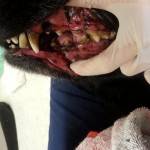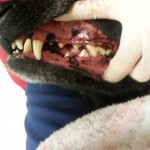Before and After

 Before and After shots of teeth that were cleaned without Anesthesia.
Before and After shots of teeth that were cleaned without Anesthesia.
HOT SPOTS
Cats rarely get hot spots, but dogs, especially thickly furred breeds like golden retrievers and Chow Chows. often develop red, wet sores that make their skin look like raw hamburger. Hot spots, known technically as moist pyotraumatic dermatitis, are caused by a wide range of things. Usually, a bug bite, tiny sore, or scratch in the skin begins to itch, the dog stats licking and chewing, bacteria start to grow, and the sore spreads incredibly fast. It can go from the size of a pinprick to several inches within 30 minutes, and if left untreated, it can grow 20 times larger in a single day. Hot spots look awful, and they may be extremely painful. But they involve only the very top layer of skin and healquickly with first aid.
Trim the fur around the sore. First apply K-Y Jelly to the spot. Once you’ve trimmed the fur, clean the sore. Any water based cleanser is fine, but any antiseptic liquid soap like Betadine Skin Cleanser is best. Make sure to rinse off the cleanser, or the irritation may become worse when the soap scum dries on the skin. Pat area dry. Medicate with an antibacterial spray or cream that dries up the sore, like a 5% benzoyl peroxide product such as Clean & Clear Persa – Gel 5, which is found at drugstores and supermarkets. No ointments or Alcohol on hot spots, because it seals the infection deeper into the skin and is too strong for open wounds and is painful.
Enhancing the Immune System
THE IMMUNE SYSTEM IS A NETWORK OF CELLS AND ORGANS that defends the body against attacks by foreign invaders. The cells communicate with each other through proteins called cytokines to mount a defensive attack. The body is mainly being defended against what are popularly called germs or microbes (bacteria,yeast, protozoan, and viruses). Because the mammalian body provides an ideal environment (warmth and moisture) for many microbes, they tend to multiply easily and rapidly in the body if the immune system has been unable to keep them out or destroy them. symptoms or illness may arise directly from the actions of the pathological organisms, from the immune system activities called upon to fight them, and /or both.
The immune systems is amazingly complex. Every time we solve a problem, two more question arise. The immune system must recognize dozens of different enemies and then produce secretions and “killer” cells to match up with and wipe out each one of them. But it gets even trickier: the immune system must produce this response only when the enemy is present; otherwise, the immune system would be draining energy and building up secretions continuously.
Milk Thistle (Silybum Marianum)
Milk thistle has been used for centuries as an herbal medicine for the treatment of liver disease. The active constituent in milk thistle is silymarin, a mixture of three flavolignans. Silybin is the most biologically active flavonoid in silymarin. Therapeutically, milk thistle acts by protecting liver cells from toxic damage, boosting glutathione concentrations, and regenerating normal liver cells. Milk thistle is also a potent free radical scavenger. In humans, milk thistle has been used clinically for a number of conditions including alcoholic liver diseased, hepatitis, amanita mushroom poisoning, and skin disease. Silymarin has also shown to enhance liver detoxification by by inhibition of Phase I detoxification while enhancing glucuronidation. One of the most important aspects of this herb is that it slows down or even reverses the formation of fibrosis (scar tissue) in the liver. This is my main herbal treatment in liver disease.
Muscle Terminology
Skeletal muscles do not work in isolation. Each muscle is attached to bony processes or sheets of connective tissue. All voluntary muscles are somehow associated with the skeletal system. The muscles to bone attachment at which the muscle begins is called the origin and the site at which it ends is it’s insertion. The origin is usually proximal and attaches to the less moveable bone, while the insertion is distal and attaches to the more moveable bone. Therefore, when a muscle contracts, the insertion moves toward the origin. For example, the deltoid muscle in the shoulder of the humerus. When this muscle contracts, the more move able it’s insertion on the humerus. When this muscle contracts, the more moveable insertion moves toward the origin and pulls the humerus toward the scapula.
Almost all skeletal muscles either originate or insert on the skeleton and many like the deltoid, have both their origin and insertion on bone. Contraction of the deltoid flexes the shoulder. It is the job of another muscle or group of muscles to extend the shoulder or to produce an opposite action. For example, the teres minor is one of the muscles that extends the shoulder. Similarly, abductors and adductors work in opposition of each other. The concept of muscles working to produce movement in opposite directions allows dogs to move their joints in both directions.




